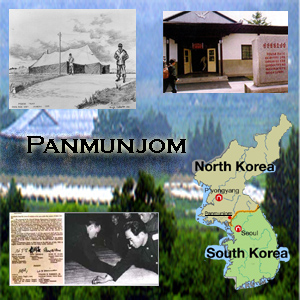
 |
Panmunjom |
| HOME |
 |

Panmunjom (P'anmunjo¨m) is a village on the border between North and South Korea. This is where the 1953 armistice that ended the Korean War was signed. It was signed on July 27, 1953, and its provisions were to bring a cease-fire to the Korean War. The Military Armistice commission and agency were established to supervise implementation of the truce terms. The building where the armistice was signed still stands, and straddles the Military Demarcation Line. This line runs through the middle of the Demilitarized Zone. It is considered to be what is left of the Cold War. Panmunjom is 48 kilometers northwest of Seoul and 10 kilometers east of Kaesong and is the headquarters of the Military Armistice Commission. It has been the location of numerous high profile incidents. North Korean guards attacked a United Nations Command work party in 1976, killing two American officers with an ax. Military Police of both sides provide security for the JSA. The guard forces have no more than 35 security personnel on duty at any given time. Military and civilian guests are permitted to visit the JSA as guests of the respective sides. Currently, the United Nations Commission (UNC) sponsors nearly 100,000 visitors each year. Most of them are tourists who make arrangements with the Korea Tourist Bureau to come visit. The other majority are military personnel who are encouraged to visit to get a better understanding of the situation in Korea. Officially called the "Joint Security Area" (JSA), this special area is outside administrative control of both South and North Korea. This area is often called the "Truce Village," but is best known worldwide as Panmunjom. |
|
|